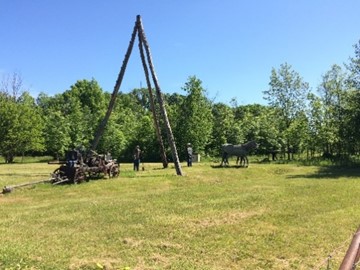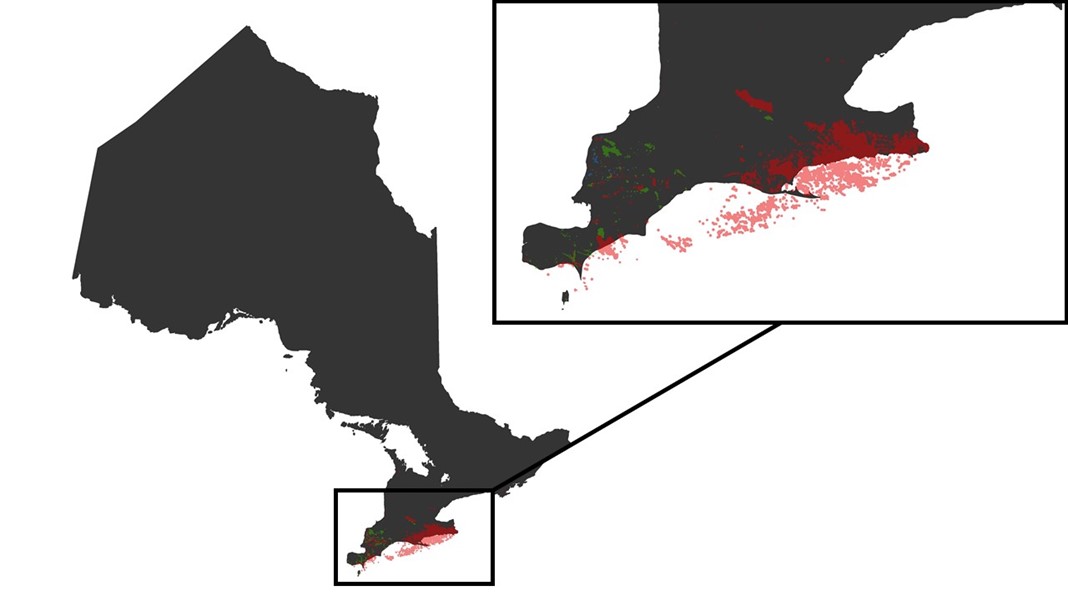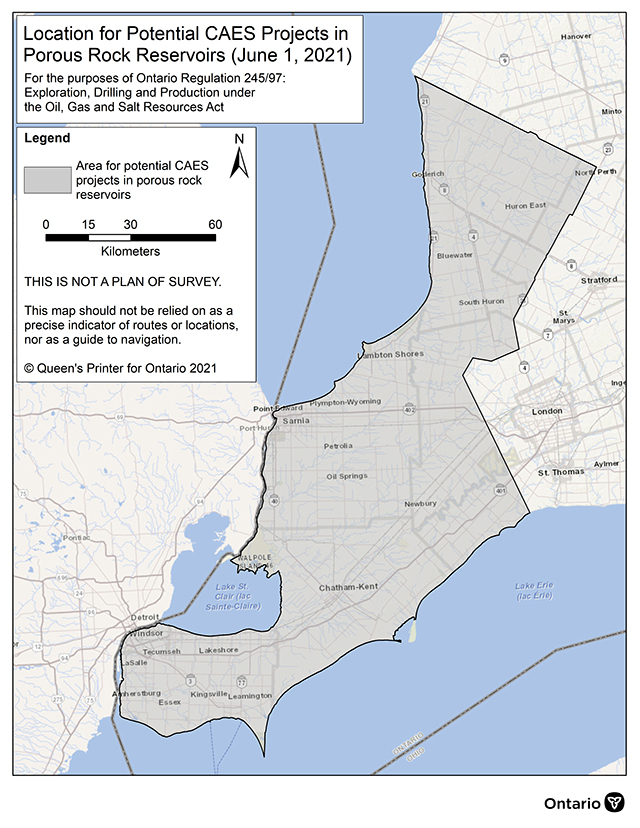Exploring for and extracting oil, natural gas and salt resources
Learn about oil, gas and salt resources, and the storage of hydrocarbons and compressed air in Ontario. Apply to explore for or extract oil and natural gas (petroleum) and salt resources, request special project designations and authorizations, and get approvals to use underground storage.
Changes to the provincial standards came into effect on July 1, 2023:
- Oil, Gas and Salt Resources of Ontario, Provincial Operating Standards
- Provincial Standards for Compressed Air Energy Storage in Salt Caverns: Applications and Operations
These changes require well operators to follow the most current edition of all external codes and standards.
Geologic carbon storage
Learn about our plan to enable geologic carbon storage as a new tool to help businesses reduce emissions.
Overview
North America’s first commercial oil well was established in Enniskillen Township in 1858. Since this historical well began production, a total of about 93 million barrels of oil and about 1.4 trillion cubic feet of natural gas have been produced as of 2017, largely in Southwestern Ontario.

Reconstruction of a tripod used for oil drilling in the 1800s in historical oil-producing areas of Lambton County.
- 337,280Barrels of oil produced in 2017
- 4.8Billion cubic feet of natural gas produced in 2017
- 200-400kTonnes of salt each year from salt solution mining operations
- About 400 million years ago, Southern Ontario was covered by shallow tropical seas full of life. The sediments and organic material in these seas turned to rock and became the source of our petroleum resources.
- The sedimentary rocks in Southern Ontario are up to 1.5 km thick and sit on top of much older rocks of the Canadian Shield.
- We have records for almost 27,000 petroleum and related wells. These are mostly located in Southwestern Ontario. Examples are:
- wells for exploration and production of oil and natural gas
- wells for storage of imported natural gas
- salt solution mining wells that produce edible table salt
- wells used for the storage of liquid hydrocarbons in underground salt caverns
- test wells that provide information about bedrock
About hydrocarbon and compressed air energy storage in Ontario
- Natural gas that is imported by pipeline from outside the province is injected into natural traps in porous rock formations below the surface to make it available for Ontario businesses and households during the high-demand months of fall and winter.
- Ontario produces approximately 0.6% of the natural gas that it uses each year. At any given time, Ontario may be storing about 30% of the natural gas that it uses in a year.
- Refineries in the Sarnia area use salt solution mined caverns to store liquid hydrocarbons underground.
- As of 2018, we have been regulating the storage of compressed air in salt caverns for the purposes of generating electricity. This is the first compressed air energy storage (CAES) operation of this kind in Canada, and is located near Goderich, Ontario.
- As of July 1, 2022, we regulate CAES projects that store compressed air in porous rock to generate electricity will also be regulated under the same framework as hydrocarbon storage and CAES in salt caverns.
Oil and gas wells in Ontario
You can use the interactive petroleum well map and searchable well records at the Oil, Gas and Salt Resources Library (the Library) website to find information about known oil and gas wells.
These tools provide location and technical data about wells regulated under the Oil, Gas and Salt Resources Act (Act) including oil, natural gas, salt solution mining, underground hydrocarbon and CAES wells. Information includes:
- the subsurface geology of Southern Ontario
- well specific locations and information
- where groundwater occurs in bedrock
Additional data and mapping services are available from the Library.

Almost all the known oil and gas pools in Ontario occur in Southwestern Ontario. Oil pools are shown as green, natural gas pools as pink and red, and pools used for natural gas storage as blue.
About oil, natural gas and salt resources
Commercial production of oil, gas and salt occurs in Southern Ontario.
The ministry licenses the drilling of wells used for:
- geological evaluation or testing within Cambrian or more recent aged rocks
- petroleum exploration or production
- secondary recovery of oil and natural gas
- storage of oil, gas or other hydrocarbons in a geological formation
- compressed air energy storage in salt caverns and porous rock
- disposal of oil field fluid in a geological formation
- salt solution mining (the process of pumping water in and out of wells to dissolve and extract salt)
- designated special projects to assess, test, pilot or demonstrate new or innovative technologies, methodologies or activities
In addition to developing and enforcing the rules governing oil, gas and salt resource management and underground storage, the ministry is responsible for managing these resources where they occur on Crown lands.
Production methods in Ontario
Oil and gas resources in the province are currently extracted by conventional methods.
There are currently no applications before the ministry requesting approval to explore for shale gas or oil, or to use high-volume hydraulic fracturing, commonly known as fracking. At this time, the ministry would not consider applications for the use of high-volume hydraulic fracturing before proper consultations with stakeholders, Indigenous communities and the public are conducted.
Rules for operators
To become a licensed petroleum, salt solution-mining and/or underground storage operator, you need to first understand the rules and adhere to them once licensed. This ensures:
- the safe and environmentally responsible development of oil, natural gas and salt resources
- the safe injection and storage of substances into underground geological formations
Here are the rules and regulations you need to know:
- Oil, Gas and Salt Resources Act
- Oil, Gas and Salt Resources Act, Regulation 245/97 (Exploration, drilling and production)
- Oil, Gas and Salt Resources Act, Regulation 425/23 (Special projects)
- Oil, Gas and Salt Resources Act, Provincial Operating Standards
- Provincial Standards for Compressed Air Energy Storage in Salt Caverns: Applications and Operations, Version 1.0
- Mining Act, Part IV (Oil, gas, underground storage and salt solution mining)
- Mining Act, Regulation 263/02 (Exploration licence, production and storage leases for oil and gas in Ontario)
Requirements based on type of land ownership
Private land
Before you can explore, drill for or produce oil and gas, solution mine for salt, or use underground storage on private land, you need to:
- be the landowner who owns the mineral rights for the property, or
- enter into an agreement with the landowners (this usually includes payment of rent and production royalties to the landowners)
Crown land
Before you can explore, drill for or produce oil and gas, solution mine for salt, or use underground storage on Crown land, you need to obtain from the ministry:
- an exploration licence to search for resources and drill geological test wells
- a production lease for the drilling, operating and plugging of wells
- a storage lease for the storage of oil, gas, air or other prescribed substances in underground geological formations using wells
Private and Crown land
On both private and Crown land, you need to obtain a well licence from the ministry before conducting any activity on a well, including:
- entering into an existing well to re-work or decommission it (if not already licensed)
- conducting geological evaluation or testing (within Cambrian or more recent aged rocks)
drilling a new well for the purpose of:
- producing resources
- disposing of oil field fluid
- storing oil, gas or other hydrocarbons
- storing compressed air in a salt cavern or porous rock to produce electricity
- injecting other substances into underground geological formations
- salt solution mining
- assessing, testing, piloting or demonstrating new or innovative technologies, methodologies or activities
Apply for a well licence
For licences related to the exploration and production of oil, gas and salt resources or the storage of hydrocarbons:
- Review Part 1 of the Provincial Operating Standards, which identifies the requirements (e.g. technical standards, how to develop a drill plan) to support your well licence application.
- Complete the appropriate application form:
- Submit your application by mail or email to:
Ministry of Natural Resources
Petroleum Operations Section
Divisional Delivery Branch, Regional Operations Division
659 Exeter Road, 4th Floor
London, Ontario
N6E 1L3
gasandoilwells@ontario.ca
Cost
Each well licence application costs $100. You can pay by cheque, debit or credit card.
For licences related to compressed air energy storage projects in salt caverns:
- Review the Provincial Standards for Compressed Air Energy Storage Applications and Operations in Salt Caverns, Version 2.0, which identifies the requirements for operations and applications.
- Submit your application in accordance with Part 2 of these Standards.
For CAES projects, both a well licence and an injection permit will be required. The application requirements for injection permits are also included in Part 2 of these Standards.
Cost
Each well licence application costs $100, and each injection permit application costs $500. You may pay by cheque, debit or credit card.
For licences related to compressed air energy storage projects in porous rock
- Review sections 2 and 2.1 of Ontario Regulation 245/97, and the definitions of ‘porous rock reservoir’ and ‘pinnacle structure’ in the regulation to determine whether your project is eligible to seek approval under the Oil, Gas and Salt Resources Act. We prohibit projects that do not meet the eligibility requirements.
- You can find the report referenced in the definition of pinnacle structure here: Early Silurian Sequence Stratigraphy and Geological Controls on Karstic Bedrock Groundwater-Flow Zones, Niagara Escarpment Region and the Subsurface of Southwestern Ontario (PDF)
- View and download the map showing the Location for Potential CAES Projects in Porous Rock Reservoirs, referenced in section 2 of the regulation.
- If your project is eligible, you will require a well licence(s) and an injection permit. The application requirements are set out in sections 2.1 through 2.11 of the regulation.
- Submit your well licence(s) and injection permit applications by mail or email to:
Ministry of Natural Resources
Petroleum Operations Section
Divisional Delivery Branch, Regional Operations Division
659 Exeter Road, 4th Floor
London, Ontario
N6E 1L3
gasandoilwells@ontario.ca
Cost
Each well licence application costs $100. Each injection permit application costs $500.
You may pay by cheque, debit or credit card.
Location for potential CAES projects in porous rock reservoirs map
Download larger version of this map.
For licences and injection permits related to special projects
You can find information about special projects in:
- sections 11.1 to 11.6 of the Oil, Gas and Salt Resources Act
- Ontario Regulation 425/23: Special Projects
Ontario Regulation 425/23 includes requirements for:
- applications for special project designations to pursue a project to test, assess, pilot or demonstrate a new or innovative technology, method or activity using a well
- associated authorizations (such as licences or permits)
We recommend you review the definitions and all parts of the regulation to determine whether your project is eligible to request a special project designation.
Applying for a special project designation
Sections 2 and 3 of Ontario Regulation 425/23 outline the requirements to apply for a special project designation, including all supporting documentation.
The minister may also request additional information under section 8
Applying for licence and injection permits
Sections 9 to 19 outline the licence and injection permit application requirements and processes.
Other requirements
Sections 20 to 23 include requirements related to:
- complying with operating standards
- posting copies of licences
- providing the ministry with notification of certain changes related to the special project
Section 24 outlines financial security requirements.
Amendments
Sections 25 to 28 outline requirements for seeking approval for amendments to, or transfer of, the special project designation or associated authorizations (for example licence or permit).
How to apply
- Follow the steps in sections 2 and 3 of Ontario Regulation 425/23 to get a special project designation.
- Once your project is designated, follow steps in sections 9 to 19 of Ontario Regulation 425/23 to apply for project authorizations (for example, licences or permits).
- Submit both applications by mail or email to:
Ministry of Natural Resources
Petroleum Operations Section
Divisional Delivery Branch, Regional Operations Division
659 Exeter Road, 4th Floor
London, ON
N6E 1L3
gasandoilwells@ontario.ca
Cost
Each licence application costs $100.
Each injection permit costs $500.
Requests for designations have no charge.
You may pay by cheque or with credit card.
Apply for a private gas well licence under the Private Gas Well Policy
Apply to license an existing private gas well
Request approval for transfer, renewal, extension or other activity
If you need to:
- transfer a well licence to another operator
- transfer a special project designation
- transfer licences or permits relating to a special project
- get an exploration licence, production lease or underground storage lease (Mining Act, Regulation 263/02)
- transfer an exploration licence, production lease or underground storage lease
- renew a production lease or underground storage lease
- extend or surrender an exploration licence, production lease or underground storage lease
You must send a written request, including relevant information, by:
- Email to gasandoilwells@ontario.ca or
- Mail or in person to:
Ministry of Natural Resources
Petroleum Operations Section
Divisional Delivery Branch, Regional Operations Division
659 Exeter Road, 4th Floor
London, ON
N6E 1L3
Cost
Each request costs $100. You can pay by, cheque, debit or credit card.
Additional approvals
Depending on where you plan to operate, you may also need approval under other pieces of legislation. Some examples are:
Ontario Energy Board Act, 1998 - Section 40
Technical Standards and Safety Authority Act, 2000
File compliance-related reports
If you are a licensed operator of a well, you need to complete and submit to the ministry, as applicable to your operations, reporting requirements including the following forms:
- well status report
- geophysical and geochemical exploration report
- salt solution mining production report
- injection report
- well drilling and completion report
- oil and gas production report
- oil field fluid disposal report
- well plugging report
- security adjustment request
Become a certified examiner
- Licensed operators under the Oil, Gas and Salt Resources Act must have their operations reviewed by a ministry-certified examiner to ensure they are following provincial regulations and standards.
We require certified examiners to file with the ministry reports about the following:
- Class 1: Drilling, plugging, casing, cementing
- Class 2: Oil and gas works, disposal
- Class 3: Solution mining
- Class 4: Hydrocarbon storage and compressed air energy storage
- Class 5: Pipeline systems
- Class 6: Compressed air energy storage in porous rock reservoirs
Those who wish to become a certified examiner must apply and pay a $25 fee. To be a Class VI examiner, one must hold a licence, limited licence or temporary licence issued under the Professional Engineers Act.
Appeal an order or launch an appeal
Our petroleum inspectors can issue orders (e.g. remediation directives) to licensed or unlicensed operators who violate the Oil, Gas and Salt Resources Act.
If you receive an order, you can appeal it within 30 days of the date the order was issued by submitting a written appeal in person or by mail to:
Director, Divisional Delivery Branch c/o Appeals Coordinator
Petroleum Operations Section
Ministry of Natural Resources
659 Exeter Rd., 4th Floor
London, ON N6E 1L3
The Ontario Lands Tribunal hears appeals under the Oil, Gas and Salt Resources Act related to:
- applications for pooling and unitization
- ministry's refusal of consent to transfer a well licence
- terms and conditions or changes to terms and conditions on a well licence
- refusal, suspension or cancellation of a licence
Learn more about launching an appeal to the Ontario Lands Tribunal.
Learn more about Oil, Gas and Salt Resources Act related decisions by the Tribunal.
